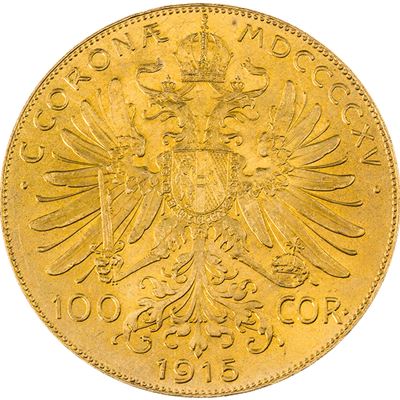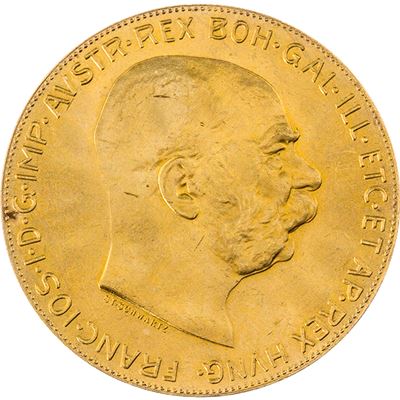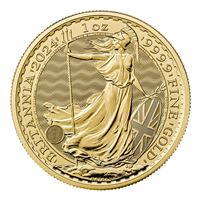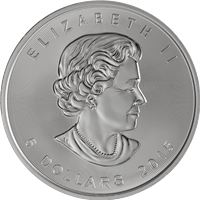Gold Austrian/Hungarian 100 Corona - (.9802 oz of Gold)




| Qty | Check / Bank Wire | Credit Card |
|---|---|---|
| 1+ | $2,339.16 | $2,421.03 |


Buy Gold Austrian/Hungarian 100 Corona - (.9802 oz of Gold)
The Austro-Hungarian Empire, like the rest of the world during the 19th and early 20th centuries, followed a gold standard for its monetary system. As such, it minted gold and silver coins that were used in regular commerce and trade.
During this time, there was no dividing line between currencies and precious metals. Coins were made of silver and gold, and these two metals were recognized as money. The arrangement was rather simple.
However, as the 20th century progressed, fewer and fewer countries adhered to a true gold standard. The amount of war debt incurred during World War II, as well as the high cost of financing the effort to rebuild Europe, made compliance with a fiscally sound monetary system tied to gold virtually impossible.
Thus began the age of fiat money. Rather than bearing or being backstopped by something of intrinsic worth, fiat money is valuable purely by virtue of government decree. In all of human history, every single fiat currency experiment has eventually failed and gone extinct.
Gold, by contrast, has maintained its purchasing power over thousands of years.
History of the Austrian Mint
Austria was once part of a powerful empire that was the successor to the Holy Roman Empire controlled by the Habsburg dynasty. Often referred to as Austria-Hungary, this dual monarchy was among the world's great powers up until the end of the First World War.
Naturally, the empire needed a world-class mint to supply its territories with coinage. It has the distinct privilege of administering what is perhaps the oldest continuously operated minting institution anywhere in continental Europe -- the Austrian Mint.
The mint was established more than eight centuries ago amid one of medieval Europe's greatest controversies.
Richard I of England, who is also popularly known as Richard "the Lionheart," was once captured near Vienna while traveling across Europe during the Crusades. He was held prisoner by the Duke of Austria, Leopold V.
Once Richard was turned over to the Holy Roman Emperor Henry VI, the equivalent of over 25,000 kilograms worth of silver was demanded as ransom for his release. The sum was eventually paid in the year 1194. Interestingly, this silver was used for the first coins struck by the Austrian Mint.
Prior to the introduction of the gold Corona/Korona coin, the Austrian Mint issued its own 4 gulden and 8 gulden coins, both of which are broadly considered florins.
Today, the same institution strikes the popular Vienna Gold Philharmonic and Vienna Silver Philharmonic bullion coins. They have become the most popular silver and gold coins for investment purposes in Europe.
Famous Gold Coins and Silver Coins from Austria
The Philharmonic series of precious metal coins now forms the flagship offering of the Austrian Mint (known as Münze Österreich in German). These coins embody the rich musical culture of Vienna, the country's capital city, but they are hardly the first or only noteworthy gold and silver coins on the extensive resume of the mint.
Perhaps the best-known among them is the Maria Theresa silver thaler. Not only did this coin become the most trusted form of silver in international trade across multiple centuries, but it honored the empress who had such a lasting impact on the economic future of the Habsburg empire.
As monarch, Maria Theresa reformed and completely overhauled the economic system used by the empire. This newfound financial stability was reflected in the amount of trust placed in the thalers. The coins were produced continuously throughout the 19th century even though the year-date in the design was frozen at 1780 after Maria Theresa passed away.
The empire reluctantly participated in the Latin Monetary Union during the 1800s. Some of its coins were compatible with those of its neighbors, but Austria-Hungary never became an official member of the union. The LMU was an attempt to bring the disparate gold coin and silver coins standards of the countries in Europe (and, later, also those in Latin America) into uniformity. The idea was to ease the costs of trade and eliminate the inconvenience and inefficiency of converting from one currency into another.
Fitting squarely within this era is the Franz Joseph gold ducat like the one offered here. Each coin is struck from .900 fine gold and, like Maria Theresa, retains the 1915 year-date to honor the emperor's death.
Gold Austrian/Hungarian 100 Corona Coin Design
The design style of these coins is representative of the bygone era that they come from. With a touch of realism, the 100 Corona gold coin mimics the distinctive artistic style known as classicism, which is patterned on the Greco-Roman ideals of art.
The obverse features the profile of Emperor Franz Joseph I of Austria, and the border is completely taken up with his monarchical titles: "Franc-Ios-I-D-G-Imp-Austr-Rex-Boh-Gal-Ill-Etc-Et-Ap-Rex-Hung" (meaning "Franz Joseph I, by the Grace of God Emperor of Austria, King of Bohemia, Galacia, Illyria etc, and Elected King of Hungary"). This may the the only time you see the equivalent of "etc" in a coin inscription, thanks to the breadth and complexity of the old empire of Austria-Hungary!
Franz Joseph's bust faces toward the right. The emperor passed away in 1914 and would continue to be immortalized in this coin design for many years thereafter.
The reverse design is graced by the crowned double eagle of Austria's imperial coat of arms, with the eagle's tail dividing the face value of 100 Corona. The two-headed eagle holds a sword in one talon and a crown in the other. These coins have random dates, but the vast majority will have the 1915 date since restrikes using that date have been made for decades. The rim inscription for the year-date is expressed in Roman numerals (MDCCCCXV). Buy low premium gold and add a historic gold piece to your collection.
The coin's dimensions measure 2.29 mm thick and 37.1 mm in diameter.
Be advised that the image shown is a stock photo for reference only. Dates on the coins you receive will be randomly chosen from available inventory at the time of order fulfillment.
Why Buy European Gold Coins?
Prior to the vast expansion of the international market for modern bullion coins during the 1980s, old European gold coins were among the only viable options for Americans to legally own gold.
Naturally, this meant that 19th-century and early-20th-century gold coins from Europe began to flow into the United States in the years following World War II. This was virtually the only way to get around the prohibition on private gold ownership because of a caveat excluding collectible coins. As they do today, European gold coins offered American investors something historically significant with a distinctive cultural legacy that still qualifies as gold bullion.
Moreover, with so many different nations and empires occupying Europe during this time period, there are an array of different options to choose from -- allowing you to customize and diversify your coin collection.
These gold coins also carry a low premium over spot compared to most numismatic coins.
If you would like gold bullion with a historical flair, consider the Austrian-Hungarian 100 Corona gold coin. This .900 fineness gold coin was first minted from 1909 to 1915, and is still produced with a 1915 year-date by the Austrian government as a bullion coin.
Not only do these coins embody the rich history of one of Europe's powerful historic empires, but they also perfectly fit gold's traditional role as a store of wealth over time.
The Legacy of Gold Coin Standards for Modern Bullion
For hundreds of years, the notion of a uniform standard for gold bullion was sought by various empires and powerful countries. It was seen as a bedrock of international trade for different nations to adhere to the same levels of quality, purity, and even artistic style.
Not only did this result in most gold coins being 90% pure gold (.900 fine) by the 19th century, but the desire for a uniform set of standards for gold coins also provided the foundations of the first truly global system of commercial exchange.
Today, thanks to improved refining technology and far greater global connectivity, it's fairly easy for mints to ensure that all of the world's physical gold bullion meets the standard of .999 fine gold. This was not the case until the late 20th century.
In place of the uniformity of the contemporary gold market, the system once operated almost solely on the basis of trust and reputation. Gold coins of higher quality and reliability were favored by traders and travelers because there was an expectation that the coin would be accepted at full value wherever one went.
One of the early coins that emerged for this purpose was the Austrian florin. Named for where they were first minted (Florence, Italy), gold florins were an important currency across Europe, especially within the Holy Roman Empire. As a great power, the Austro-Hungarian Empire was keen on minting its own gold coins for trade.
Historic Pre-1933 Gold Coins
1933 is an important cut-off date for numismatics, particularly in the case of circulating gold coins. The very first commemorative coins were still in their infancy at the time, and they were all made of silver.
The date has persisted as a key turning point in numismatic hsitory. It was effectively the end of the era of the a true gold standard. Beginning in 1933, private gold ownership was virtually outlawed in the United States, thanks to Executive Order 6102 issued by Franklin D. Roosevelt. This act by the president is commonly referred to as "Gold Confiscation."
After this point, gold coins were no longer produced in most of the countries around the world. Although a sort of indirect gold standard known as the Bretton Woods agreement survived the postwar era until 1971, the world's financial system became increasingly based upon paper notes and fiat currencies following gold confiscation in 1933.
In fact, the revival of gold bullion coins issued by government mints didn't arrive in full force until the 1980s. For nearly half of a century, gold coins of any kind were difficult to come by no matter where you lived on the planet. For this reason, numismatists and scholars have emphasized the importance of "pre-1933" gold as the demarcation line between distinct eras in the history of coinage.
Pre-1933 Gold Carries Low Premiums
Another advantage (aside from preserving history) of gold coins from the 19th and 20th centuries is the premium over spot they carry. This premium above the melt value of the metal is higher for more collectible items. However, because European gold coins such a the Austria-Hungary 100 Corona are treated primarily as bullion by investors, they often have very low premiums.
If there's one thing that bullion investors are most concern with, it's finding gold and silver items that are priced as close to the spot price of the underlying precious metal as possible.
Anyone who wants to stack as much gold as possible on a budget should avoid highly collectible coins as well as jewelry, which carries a steep mark-up due in part to the high cost of fabricating intricate pieces of jewelry and ornamentation.
Choosing Gainesville Coins for Your Next Bullion Purchase
Gainesville Coins maintains a massive inventory of different gold, silver, and platinum bullion products. This includes low-premium bars and rounds in addition to coins.
We (and our customers) benefit from a decade of experience as an online bullion dealer as well as a seasoned brick-and-mortar coin shop. Our friendly, helpful traders and customer service representatives don't earn commission. Our staff proudly operates like a tight-knit family.
As a full-service coin and bullion dealer, we also offer fully secure vault storage at our depository. We have the expertise to assist customers in opening a precious metals IRA.
GC makes it easy when you sell to us, providing a straightforward two-way market for gold and silver bullion. Thanks to our high volume of sales, we can offer very low premiums on all of our bullion items.

Specification
Related Products
Customer Ratings & Review
Review This Product
Share your thoughts with other customers.






